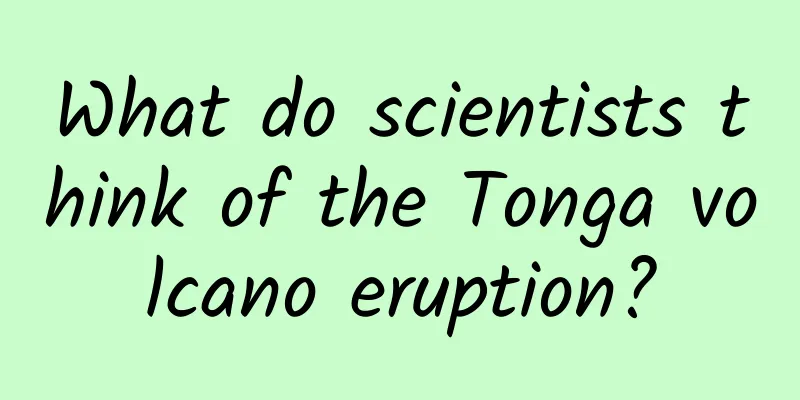What do scientists think of the Tonga volcano eruption?

|
The massive eruption of an underwater volcano in the South Pacific has caused a stir in global public opinion. Let's listen to scientists from various fields interpret the process and impact of the volcanic eruption from a professional perspective. On January 15, a large-scale volcanic eruption occurred in the waters of Tonga, an island nation in the South Pacific, triggering a tsunami disaster that affected the entire Pacific Rim region. This "unexpected" volcanic eruption instantly made the South Pacific island nation with a total population of 100,000 people the focus of global attention. Some experts speculate that this volcanic eruption is the most powerful on Earth in the past 30 years. The secondary disasters caused by the volcanic eruption not only caused Tonga to "lose contact with the whole country" for a time, but may also continue to have unpredictable impacts on the global ecological environment and climate environment. Since the volcanic eruption was sudden and rare in history, the large-scale humanitarian rescue was followed by discussions and questions from the public and professionals on related scientific issues. The reporter interviewed professionals in geology, climate, oceanography and other fields to interpret the process and impact of the volcanic eruption from a scientific perspective. Why can underwater volcanic eruptions cause "water and fire to merge"? As we all know, water and fire are incompatible. But in the Tonga volcano eruption, the vast Pacific Ocean not only failed to "extinguish" the volcano, but even contributed to the power of the eruption. How did this phenomenon of "water and fire blending" come about? First of all, we need to make it clear what exactly is ejected from submarine volcanoes? At first glance, it is indeed similar to "fiery eruption", but in fact it is not fire, but magma, a molten substance like molten steel. Magma comes from the asthenosphere of the earth. It is the molten state of rock. It is flowing and has a temperature of thousands of degrees Celsius. Because of the high temperature and high pressure environment under the earth's crust, a large amount of magma is stored. When the plates move frequently, the magma will break through the crust under the action of high pressure and gush outward, forming a volcanic eruption. Fire is formed by the violent oxidation between the burning material and the air. The principle of water extinguishing fire is, first, to reduce the temperature, and second, to isolate oxygen. Without oxygen, the burning material cannot continue to oxidize, and the combustion naturally stops. Magma is different. Its eruption is caused by high pressure underground, and it does not require any combustible materials or combustion materials. When the hot magma comes into contact with the cold sea water, the high temperature causes the nearby sea water to quickly turn into water vapor. This is the dramatic scene when "water and fire merge". ▲From the remote sensing images of my country's Gaofen-1B satellite, we can see that a large amount of red and brown pumice is floating in the sea area dozens of kilometers around Hongahaapai Island, ranging in length from a few meters to more than 10 kilometers. Pumice is formed by the contact between volcanic lava and seawater. Its main component is usually silicon dioxide, which is soft in texture and has a small specific gravity. Under the action of waves, it gathers together to form a large area of pumice, which will not only affect the navigation of ships, but also cause fish resources in the sea to die due to swallowing pumice (Image source: CCTV News) The medium of submarine volcanic eruption is different from that of terrestrial volcanic eruption (one is seawater, the other is air). Since the resistance of air is smaller than that of seawater, it stands to reason that the eruption of a volcano on land will be more violent for the same scale. But the reality is that the eruption of submarine volcanoes is sometimes more violent. This is because the eruption of magma will cause the seawater to boil rapidly, generating high temperature and a large amount of gas in a very short time, so the eruption of submarine volcanoes is easily accompanied by violent explosions. Of course, some submarine volcanic activities are relatively mild. When the seawater and magma come into contact, the seawater continues to boil, which continuously cools the magma, and eventually the magma cools into a solid state and covers the seabed. If the magma erupts too much, it will accumulate and emerge from the water to become an island. How difficult is it to warn of a volcanic eruption? Based on the current situation, most scientists believe that the level of the Tonga volcanic eruption is relatively strong, VEI5 or VEI6 (Volcanic Explosivity Index). In today's highly developed technology, why is there still no early warning of such strong volcanic activity? At present, it is very difficult to monitor volcanic eruptions (especially submarine volcanoes). Volcanoes are the product of magma activity. When the magma deep underground is under great pressure, it will erupt to the surface to form a volcano. If the volcano is located at the bottom of the ocean, it is called a submarine volcano. It is estimated that there are about 20,000 submarine volcanoes on the earth, mostly distributed in areas with active plate tectonics and magma activity, such as mid-ocean ridges and island arcs. Among these 20,000 volcanoes, some have died, some are still young and active, and others are dormant. For example, the famous Hawaiian Islands are actually an archipelago formed by volcanic eruptions. The most volcanically active region in the world happens to be the Pacific Ocean. In geology, there is a term called the "Pacific Ring of Fire". This volcanic belt roughly surrounds the entire Pacific Ocean, with a total length of more than 40,000 kilometers. There are more than 500 active volcanoes, and the Tonga volcano is just one of them. There are so many volcanoes in the world, and submarine volcanoes are distributed in the vast oceans. With the current level of human geological research and ocean exploration, it is difficult to achieve intuitive monitoring of the activities of submarine volcanoes, and we can basically only "let it go." ▲Monitoring distribution map of active volcanoes in my country. Jilin Changbaishan Volcano, Longgang Volcano, Heilongjiang Wudalianchi Volcano, Jingbohu Volcano, Yunnan Tengchong Volcano and Hainan Qiongbei Volcano have been included in the China Volcano Monitoring Network. Various monitoring methods including earthquake, gravity, deformation, fluid, etc. are used in the real-time monitoring of these active volcanoes (Image source: Sichuan Online) For submarine volcanoes, the current common method is to calculate the next possible active period and time based on existing eruption data, but the scientific accuracy of this data is not high and the method is relatively primitive. Because of this, it is not certain when the Tonga volcano eruption will end, because volcanic activity is on a geological time scale, not a human time scale, and eruptions can last for days, weeks, or even months. It can only be said that the intensity of subsequent eruptions may be weakened. This is similar to the reason why aftershocks last for years or even decades after an earthquake. Will volcanic eruptions cause a global cooling 'year without summer'? After the Tonga volcano erupted, some speculations about the impact of volcanic ash on the climate have been troubling people's nerves - a large amount of volcanic ash enters the stratosphere and cannot settle for a long time, producing a "sunshade effect" and causing a "year without summer" with a drop in global temperature. Is there any scientific basis for this statement? Volcanic eruptions are indeed associated with a drop in global temperatures. But so far, the impact of the Tonga volcano on global temperatures will not be significant. Volcanoes do cause the Earth to "cool down", mainly because they inject sulfur-containing aerosols into the atmosphere. When these aerosols enter the stratosphere, they reflect more sunlight, thus producing a cooling effect in the atmosphere. In the past 100 years, there have been three large-scale low-latitude volcanic eruptions, namely Mount Agung in Indonesia (2019), El Chichon in Mexico (1982), and Mount Pinatubo in the Philippines (1991). In the winter of the year after their eruptions, the temperature in most parts of my country, except for Northeast China and Xinjiang, was relatively low. But when it comes to climate impact, the scale of the volcanic eruption is a key factor that must be considered. The eruption of Mount Pinatubo in the Philippines, which caused the global average temperature to drop by 0.5°C, had a VEI of 6. Its eruption in 1991 released 20,000 kilotonnes of sulphur dioxide. The estimated VEI for this Tonga volcano eruption is 5-6, but the amount of sulphur dioxide released on the first day of the eruption was only 62 kilotonnes, which will not have a significant impact on global temperatures. ▲According to observations by my country's Fengyun-4B satellite, most of the mineral particles in the volcanic ash cloud hovered around the volcanic eruption point and gradually settled, while light-colored clouds gradually separated from the volcanic cloud and gradually spread westward. Analysis shows that this part of the cloud is mainly composed of acidic gases such as sulfur dioxide (Image source: CCTV News) A series of studies have shown that volcanic eruptions generally have a lasting impact on the global and East Asian climate in the next 1-2 years, causing a certain cooling effect. For my country, volcanic eruptions may also weaken the intensity of the East Asian summer monsoon in the following year, causing my country's summer rain belt to shift southward, affecting the rainfall during the entire flood season. Is it a blessing or a curse for marine ecology? After the Tonga submarine volcano erupted, a huge amount of volcanic ash, magma, and sulfide fell into the sea and drifted with the ocean currents. What impact will they have on marine life? Will they damage the ecological environment of my country's coastal areas? At the moment an underwater volcano erupts, the surrounding seawater quickly heats up and boils, causing a devastating blow to nearby marine life; the magma erupted by the volcano covers the seabed, causing the death of a large number of underwater creatures; the large amount of sulfide carried in the lava is also toxic to marine life farther away. The indirect impact of volcanic eruptions is long-term and wide-ranging. As a large amount of volcanic ash blocks sunlight, the photosynthesis of algae in the seawater will be weakened. Algae are primary producers in the marine ecosystem, producing oxygen and supplying organic matter through photosynthesis to feed other marine animals or microorganisms. Once the algae decrease, the biomass of the sea area will decrease, which may lead to fundamental changes or even collapse of the community structure in the ecosystem in the area. Volcanic eruptions can also cause the turbidity of seawater in a certain area to increase, which will not only further affect the photosynthesis of algae, but the turbid particulate matter will also adhere to or cover the coral reefs, blocking the breathing and filtering holes of reef-dwelling organisms and killing coral polyps and other reef-dwelling organisms. ▲Affected by the tsunami caused by the eruption of Tonga's submarine volcano, a total of about 30 fishing boats in Japan were capsized or sank, and fishing and aquaculture equipment were damaged in many places (Photo source: Global Times) From another perspective, volcanic eruptions cause sea water temperatures to rise and toxic and harmful substances to increase, which may cause the genetic mutation of marine organisms to accelerate. A few days ago, news about a "bumper harvest of wild yellow croaker" was all over the internet. Some netizens believed that this was related to the eruption of the Tonga submarine volcano. In fact, there is insufficient scientific basis for this suspicion. Yellow croaker is one of the main economic fish species in China's coastal waters. It was not driven from the ocean by the volcanic eruption. The fact that a fishing boat can catch so many yellow croakers in one net is mainly the result of my country's implementation of summer fishing moratorium measures and strengthening of marine environmental protection measures for many years. In addition, the fishing capacity of fishing boats and the radar detection and tracking capabilities of fish schools have been greatly improved, and the fish schools happen to spend the winter in the wintering grounds (waters where fish and shrimp gather to spend the winter). As to whether the gathering of fish schools is related to the earthquake and tsunami caused by the eruption of the Tonga submarine volcano, this possibility is not high, but we cannot completely rule out the possibility that the earthquake waves and tsunami waves transmitted to the Chinese coastal waters caused the yellow croaker to gather and form a larger school of fish in a short period of time. Produced by: Science Central Kitchen Produced by: Beijing Science and Technology News | Beijing Science and Technology Media Welcome to share to your circle of friends Reproduction without authorization is prohibited |
Recommend
8 essential skills for a popular live broadcast room
Have you ever encountered such a situation? The l...
The most advanced domestically produced "electric car" has a speed of only 0.2 kilometers per hour?
The winning works of the 2023 "China Science...
Nitrite is produced during the pickling process, so we can’t eat a single bite of kimchi?
Pickles are a traditional Chinese food. The most ...
Astronomy's biggest event: Huge gravitational waves! Captured!
Rumors of a major discovery in astrophysics had b...
12 tips | Key points you need to know about creating advertising slogans
I won’t accept any gifts this year, and if I do, ...
Douban Competitive Product Analysis
As a gathering place for literary and artistic yo...
A diver was bitten by a moray eel underwater and his blood turned green...
Tim Powell is a diving enthusiast. In 2010, he up...
8 sets of information flow advertising ideas + 2 types of combination targeting, Get it! | Gaming Industry
Among Baidu's information flow resources, Bai...
How dangerous is asthma? This article answers questions about asthma
If early intervention is carried out on asthma pa...
Viral communication case analysis: Why did “Watermelon Footprints” go viral on WeChat Moments?
On May 31, the Moments were suddenly flooded with...
Will Shanghai’s delayed retirement plan be officially implemented in 2022? What are the specific regulations? Attached the latest news
Recently, the 14th Five-Year Plan for Pension ann...
Under the trigger of "one yuan course", how can online education platforms seize the high ground?
In 2011, New Oriental Youneng Middle School took ...
Huawei Mate 20 Pro removed from Android Q list, no hope for update?
On May 23, according to Phone Arena, Google quiet...
Which housing loan interest rate is better? The difference between fixed and floating interest rates in 2020
When converting the pricing of existing mortgage ...
Beware! You may have been "exposed" online!
Have you ever received a call like this? The othe...









